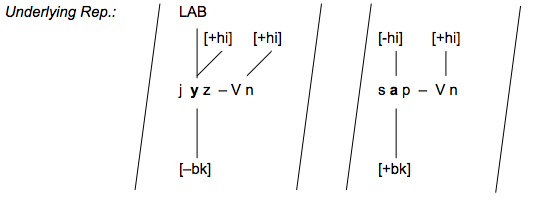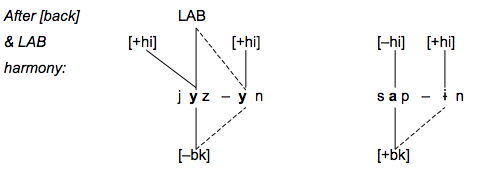Phonology: case studies
By Scott Myers and Megan Crowhurst
Department of Linguistics at the University of Texas
Back/Labial harmony with high suffix vowels
Now, let's break this set down, and consider subsets of the forms in (2) separately, beginning with (3). There are two things to notice about the forms in (3). First, the vowel in the genitive suffix is the high front nonround vowel [i], and second, the vowel in the root is also a front nonround vowel, either the high vowel [i], or the nonhigh vowel [e].
| (3) |
| Last Root V | Nom | Gen | Gloss | ||
|---|---|---|---|---|---|
| [i] | ip | ipin | 'rope' | ||
| tjilci | tjilcin | 'fox' | |||
| [e] | el | elin | 'hand' | ||
| cep | cepin | 'cap' |
The forms in (4) add another piece of information. This set is consistent with the set in (2) in that the suffix vowel appears as [-back] when the root vowel is [-back]. The forms in (4) show in addition that when the stem vowel is round, the affix vowel is also round.
| (4) |
| Last Root V | Nom | Gen | Gloss | ||
|---|---|---|---|---|---|
| [y] | jyz | jyzyn | 'face' | ||
| ɟyt͡ʃ | ɟyd͡ʒyn | 'power' | |||
| [ø] | cøj | cøjyn | 'village' | ||
| ɟøz | ɟøzyn | 'eye' |
We can complete our initial observations by noting that the forms in (5) show a different, yet similar correspondence between suffix and root vowels: when the root vowel is [+back], so is the suffix vowel, and the suffix vowel also has the same rounding specification as the root vowel.
| (5) |
| Last Root V | Nom | Gen | Gloss | ||
|---|---|---|---|---|---|
| [ɨ] | kɨz | kɨzɨn | 'girl' | ||
| arɨ | arɨn | 'bee' | |||
| [a] | t͡ʃan | t͡ʃanlar | 'bell' | ||
| sap | sapɨn | 'stalk' | |||
| [u] | pul | pulun | 'stamp' | ||
| boru | borun | 'pipe' | |||
| [o] | son | sonun | 'end' | ||
| jol | jolun | 'road' |
To summarize the observations we've made so far: the vowel in the genitive suffix agrees with the preceding vowel for the backness and rounding, where [+round] is transferred through the labial place node, LAB. The genitive vowel is always [+high] - it does not take on the height properties of the root vowel (cf. sapɨn, sonun, etc.). Thus, the suffix vowel shows a four-way alternation so that there are four surface allomorphs of the genitive suffix: -in, -un, -yn, and -ɨn. The process that gives rise to these alternations is a type of vowel harmony (vowel-to-vowel feature transfer, or agreement). In this particular case, the harmonizing features are [back] and LAB (Labial place features).
Note that it is difficult to perform a phonemic analysis for the suffix vowel. On the basis of their distribution alone, we can't tell which of the allophones [i], [u], [y], or [ɨ] is the basic allophone, because none of the allophones is more restricted on the surface than any of the others. That is, the context in which each allophone appears can be stated in equally simple terms:
| (6) | Allophonic distribution of [+high] suffix vowels: | |
| [i] | after front nonround vowels [i, e] | |
| [y] | after front round vowels [y, ø] | |
| [ɨ] | after back nonround vowels [ɨ, a] | |
| [u] | after back round vowels [u, o] | |
So, how should we analyze the underlying representation for the suffix vowel? One possibility would be to treat the vowel in the genitive suffix as unspecified for the features [back] and LAB. In an analysis that relies on underspecification (incomplete feature specification), the suffix vowel does not have values for [back] and LAB in the phonemic representation. Instead, a suffix vowel is assigned a value for [back] and LAB (if present) through assimilation to the preceding vowel as the result of a rule such as Back/Labial Harmony, stated informally in (7).
| (7) | Back/Labial Harmony with [+high] suffix vowels: A [+high] suffix vowel assimilates the backness and rounding of the preceding vowel in the root. | |
| (8) | Derivational rules | |
| a. | Back Harmony (initial version) | |
 |
||
| Note: In the rule above, alpha is a variable that stands for the relevant value of the feature [back], whether [+back] or [-back], of the trigger vowel. | ||
| b. | LABIAL Harmony | |
 |
||
The figure in (9) is a schematic autosegmental representation that models Back and Labial Harmony as the spread of the features [back] and LAB (if present) from the root to the suffix vowel - a kind of assimilation. (We will assume that the LAB node subsumes the feature [+round], and that LAB is not specified for nonround vowels in underlying representation.)
| (9) | Autosegmental model: | |
 |
||
 |
||
This concludes our initial description of vowel harmony as it affects [+high] suffix vowels in Turkish. Now let's look at what happens with nonhigh suffix vowels.